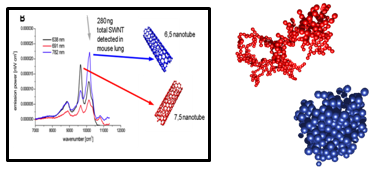Nanoparticles (NP) are utilized in industrial, commercial and medical sectors for diverse applications. Despite wide-scale use, we have limited understanding of the biotoxicity associated with NP exposures which has led to mounting concerns regarding potential health effects, particularly mediated through inhalation. There is exceptional interest in single-walled carbon nanotubes (SWNT) as they are abundantly used in a wide array of products (Liang and Chen, 2010). Several in vivo studies report that SWNT induce pulmonary cytotoxic, inflammatory, and fibrogenic responses (Li et al., 2010; Teeguardenet al., 2010). Additional concerns surround their ability to modulate the behavior of infectious agents. Numerous studies exemplify that exposure to particles and fibers (diesel exhaust, asbestos etc.) enhance susceptibility to bacterial and viral infections through synergism of inflammatory processes (Hatch et al., 1985). Although biological consequences of SWNT exposure in the lung have been recently documented, few studies have focused on the ability of NP to modulate infections by pathogenic agents (Shvedovaet al., 2008; Cestaet al., 2009). This deficit highlights the need for further exploration into the local pulmonary effects of SWNT and how these responses modulate infections and injury caused by biologic entities.
A primary mechanism for recognizing invading foreign agents occurs through activation of toll-like receptors (TLRs), a family of proteins which initiate production of pro-inflammatory cytokines through transcription factors, namely Nuclear Factor Kappa Beta (NF-κβ), and Interferon Regulatory Factors (IRFs) (Medzhitov, 2001; Seya et al., 2005). Using a bottom up approach consisting of in vitro and animal models, our long term goal is to understand the potential of NP to mediate human lung disease. As a step toward this goal, the objective of this application is to characterize the immunomodulatory consequences of chirally-distinct and surface modified SWNT in lung cells and tissues. Furthermore, we will investigate the synergistic capacity of SWNT and Influenza A virus (IAV) in producing biologic effects. We will focus on immunomodulation mediated by TLRs since our preliminary data show that pristine (non-functionalized) SWNT activate and alter expression of these receptors.
Based on the current body of knowledge and preliminary data our central hypothesis is that SWNT of distinct chirality/diameter and surface chemistry modulate TLRs resulting in the production of cytokines through activation of NF-κβ and/or IRFs. Furthermore, combined exposures of SWNT and IAV will synergistically activate TLR pathways leading to enhanced inflammation and injury. The following 3 specific aims are designed to test this hypothesis.


 National Institute of Health, R-01; Award # R01-HL 114907
National Institute of Health, R-01; Award # R01-HL 114907